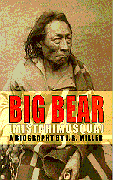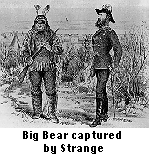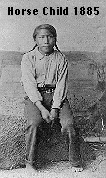

![]()

|
Big Bear (Mistahimusquay).
James R. Miller.
Grades 10 and Up / Ages 16 - Adult.
***/4
|
excerpt:
For Big Bear and others, the early years of the 1870s were both the high point of development and the edge of a slope to destruction. Their society was intact, and their economy, especially in years such as 1968 when the spirit of the buffalo helped them so generously, was well developed. . . . Although there were certainly challenges a-plenty to Plains people in these years, the Cree were far from being a defeated or even a cowed nation. . . . They certainly were not ready to accept control by another people or complete loss of their territory. What had this Queen's representative, this Archibald, meant when he urged them to conduct themselves like good subjects of the queen mother?
PROFESSOR JIM MILLER'S Big Bear (Mistahimusquay) is not a complete biography of the Plains Cree leader. Although specific references are made to Big Bear (1825-1888), much of the early material provides a general ethnographic study of Native life from the early 1800s through the 1870s. The material included touches on individual lives, community affairs and obligations, inter-tribal relationships, and the consequences of white trade and settlement.

We come to understand how Big Bear would have been raised and the expectations that would have been placed upon him as a male and as the son of a chief. Miller has given the general reader or the beginning student in Canadian history interesting and informative material. This background is presented clearly; hopefully it will also lead students' thoughts into new areas of historical exploration.
But the real story of Big Bear begins in the 1870s, when he fully assumed his role as an influential Native leader, and continues though to his imprisonment following the 1885 Northwest Rebellion. During the 1870s, the Canadian government worked to ensure that western settlement be orderly and peaceful. Throughout the decade they concluded treaties with Native tribes from northwestern Ontario to the Rocky Mountains. Although his fellow chiefs agreed to deal and signed Treaty Six in 1876, Big Bear refused. He was sceptical about Canada fulfilling its treaty obligations and believed that Natives were giving up too much freedom for too little security.

Miller believes the strained relationship between Big Bear and Canada's officials was poisoned when the whites misinterpreted Big Bear's highly rhetorical phrases -- commonly used in the Cree language. According to Miller's thesis, the tragedy that befell Big Bear was simply a consequence of cultural and linguistic misunderstanding.
The treaty officials believed Big Bear was threatening them, that he was a ``trouble-maker," and a potentially violent threat to peaceful western expansion. ``This fateful misunderstanding," Miller writes, ``was both a revelation of the cultural abyss that separated Cree and Canadian negotiators and a foreshadowing of where misunderstanding would draw both Cree and Canadian negotiators over the next decade."
Because of this misunderstanding, Big Bear, who had always wanted to follow a peaceful path, was unjustly persecuted. When some of his followers turned to violence during the Northwest Rebellion, he was arrested and then convicted for felony treason, and imprisoned at Manitoba's Stony Mountain Penitentiary. While Big Bear was in prison, he became seriously ill -- he was released in 1886 and died in 1888.
Miller presents an interesting and challenging thesis in a generally enjoyable book. One annoying problem prevents the book from receiving the highest recommendation for high-school readers: at times the text suffers from the turgid and convoluted style so often found in academic history. Professors -- liven up your writing! We really don't want students to think Canadian history is boring.
Recommended.
Ian Nelson works at Lord Nelson school in Winnipeg and at the University of Winnipeg library.
To comment on this title or this review, send mail to cmeditor@mts.net.
![]()
Copyright © 1996 the Manitoba Library Association.
Reproduction for personal use is permitted only if this copyright notice
is maintained. Any other reproduction is prohibited without permission.
Published by
The Manitoba Library Association
ISSN 1201-9364
![]()